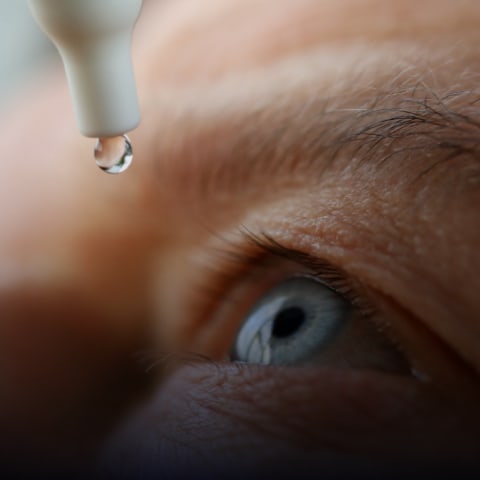We know parents want to help their children have every opportunity to develop their vision to its fullest potential. Children’s eye exams provide an opportunity to do just that by making it possible to detect conditions like a lazy eye (amblyopia) early and treat them before they get worse.
It’s recommended to treat a lazy eye as early as possible, often before children are 8, but a lazy eye can still be treated with vision therapy later in life. For many people, it’s never too late to get treatment. Speaking with an eye doctor can help you determine when you should get started with vision therapy.
What Is a Lazy Eye?
Lazy eye, or amblyopia, is a vision disorder that can affect children. It typically manifests as reduced sight in 1 eye, which can result from either a misalignment of the eyes (strabismus) or a significant difference in vision strength between each eye.
When the brain receives a stronger signal from one eye over the other, it may begin to rely on the stronger eye, neglecting visual input from the weaker one. The affected eye can then fail to develop normal visual acuity, leading to amblyopia.
Early detection of lazy eye is important, as the condition is typically most reactive to treatment during the early years of a child’s life when the visual system is actively developing. When amblyopia is treated before the age of 8, it can often be completely resolved.
What Are the Signs of a Lazy Eye?
The signs and symptoms of amblyopia can be subtle, and some kids might not even realize they’re experiencing a vision issue. Therefore, parents must be vigilant and look for warning signs, including:
- Eyes that are misaligned (inward or outward turning)
- Squinting or closing 1 eye often
- Head tilting
- Excessive rubbing of 1 eye
- Bumping into objects on 1 side
Children with a lazy eye may have difficulty with coordination and may struggle in school if they can’t see the teaching material. When you notice any of these signs, a comprehensive eye exam is the first step towards potential intervention.
What Causes a Lazy Eye?
A lazy eye isn’t really “lazy.” Rather, the change in vision often results from a breakdown in communication between the eyes and the brain. When the brain can’t combine the information from both eyes into a single, clear image, it may decide to ignore an eye, leading that eye to become even weaker.
Some eye conditions that can cause lazy eye include:
- Strabismus (turned or crossed eyes)
- Uncorrected refractive errors
- Cataracts
Some people can be born with amblyopia, while others may develop it later in life.
The Importance of Early Intervention
A child with amblyopia may experience a range of symptoms from mild to severe vision impairment. However, the real importance of early intervention lies in the fact that this is a critical period for visual system development.
The brain’s ability to adapt and improve the vision of the affected eye can decrease as a child grows older. The longer the delay in treatment, the less likely it may be that vision in the lazy eye can be fully restored. Ignoring treatment could lead to permanent vision loss in the lazy eye.
Determining the optimal time for lazy eye treatment hinges on a child’s age and developmental stage. Early childhood (2–8 years) is typically the golden age for treating amblyopia because visual functions are still rapidly developing.
Treating Amblyopia at Older Ages
Treating amblyopia can be more challenging for older children, teens, and adults because the visual system has already undergone substantial development, making it more resistant to change.
Although treatment at this stage is possible, the changes may be relatively smaller, and the process may take longer, leading to a possible need for more intensive intervention, such as surgery to realign the eyes.
Vision Therapy for Lazy Eye
Vision therapy involves a series of structured activities to train the eye-brain connection. This therapy can include exercises to improve eye coordination, focus abilities, and strength. It’s designed to help people with eye conditions—including lazy eye—train essential visual skills.
Your child’s eyes are unique, so their vision therapy plan must be customized to focus on the specific skills they need to improve. For lazy eye, vision therapy could work on forcing the brain to use the weaker eye and promote its development. This may include exercises involving lenses, prisms, and filters that can be done in the office or at home.
Occlusion therapy may be used if an uncorrected refractive error is causing amblyopia. This type of exercise involves covering the stronger eye with a patch or occluder or blurring it temporarily with atropine eye drops for a certain period of time each day.
For some rare cases of amblyopia caused by strabismus, surgical intervention may be necessary. The goal of strabismus surgery is to align the eyes and help re-establish vision coordination between both eyes.

Let’s Explore Vision Therapy Together
In the realm of visual development, timing is everything. Lazy eye treatment is a multi-faceted process that encompasses detection, intervention, and support. Early detection can pave the way for effective treatment, potentially preventing long-term impacts on a child’s vision and quality of life. If you suspect your child has a vision problem, book an eye exam at Olds, Carstairs, and Sundre. You have the power to safeguard your children’s sight. By taking proactive steps and staying vigilant, you can help your child’s sight flourish!


































